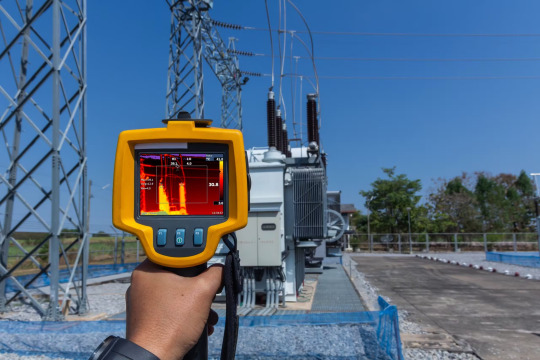Text
Unlocking the Power of Infrared Scanning: A Comprehensive Guide
Introduction
In today's world of advanced technology, infrared scanning has emerged as a powerful tool with diverse applications across various industries. Understanding the capabilities and benefits of infrared scanning is crucial for unlocking its full potential and harnessing its power for a wide range of applications.

Understanding Infrared Scanning
What is Infrared Scanning?
Infrared scanning, also known as thermal imaging, is a non-contact technique used to detect and visualize temperature differences in objects and surfaces. It relies on the principle that all objects emit infrared radiation, which varies with temperature. By capturing and analyzing infrared radiation, thermal cameras can create visual representations of temperature variations.
How Does Infrared Scanning Work?
Infrared scanning works by detecting the infrared radiation emitted by objects and converting it into a visual image. Thermal cameras use specialized sensors to measure the intensity of infrared radiation emitted by different surfaces. These measurements are then processed to create thermal images or thermographs, which depict temperature variations as different colors or shades.
Types of Infrared Scanners
There are various types of infrared scanners available, ranging from handheld devices to advanced thermal imaging cameras. Handheld infrared thermometers are commonly used for spot measurements, while thermal imaging cameras offer real-time imaging capabilities and higher resolution for detailed inspections.
Applications of Infrared Scanning
Infrared scanning has numerous applications across different industries, including:
Building Inspections
Infrared scanning is used for building inspections to identify issues such as heat loss, moisture intrusion, electrical faults, and insulation deficiencies. By detecting temperature anomalies, thermal imaging helps pinpoint areas of concern and prioritize repairs.
Electrical Inspections
In the electrical industry, infrared scanning is employed to detect overheating components, loose connections, and overloaded circuits in electrical systems. Regular infrared inspections can help prevent equipment failures, reduce downtime, and enhance safety.
Mechanical Inspections
Infrared scanning is utilized for mechanical inspections to identify issues such as bearing wear, misalignments, and lubrication problems in machinery and equipment. By detecting thermal anomalies, infrared scanning helps diagnose potential issues before they escalate into costly failures.
Medical Diagnostics
In the medical field, infrared scanning is used for diagnostic purposes, such as detecting inflammation, monitoring blood flow, and identifying abnormal tissue growth. Thermal imaging technology offers non-invasive and radiation-free imaging techniques for various medical applications.
Advantages of Infrared Scanning
Non-Destructive Testing
One of the key advantages of infrared scanning is its non-destructive nature, allowing inspections to be conducted without disrupting operations or causing damage to equipment or structures.
Time and Cost Savings
Infrared scanning enables rapid and efficient inspections, reducing the time and labor required for traditional inspection methods. By identifying issues early, infrared scanning also helps avoid costly repairs and downtime.
Enhanced Safety
By detecting potential hazards such as electrical faults, mechanical failures, and structural defects, infrared scanning helps improve safety in various industries, reducing the risk of accidents and injuries.
Challenges and Limitations
Environmental Factors
Environmental factors such as ambient temperature, humidity, and air movement can affect the accuracy and reliability of infrared scanning results, requiring careful consideration during inspections.
Accuracy and Resolution
While infrared scanning provides valuable insights into temperature variations, its accuracy and resolution may be limited by factors such as distance, emissivity, and sensor quality.
Training and Expertise
Interpreting infrared images requires specialized training and expertise to distinguish between normal variations and potential issues accurately. Proper training and certification are essential for reliable and accurate inspections.
Best Practices for Infrared Scanning
Proper Equipment Calibration
Calibrating infrared equipment regularly ensures accurate temperature measurements and reliable inspection results. Proper calibration procedures should be followed according to manufacturer guidelines.
Understanding Thermal Patterns
Understanding thermal patterns and interpreting infrared images correctly is crucial for identifying anomalies and potential issues during inspections. Thermal anomalies should be investigated further to determine their root causes accurately.
Conducting Thorough Inspections
Thorough inspections involve scanning all relevant surfaces and components to detect potential issues comprehensively. Inspectors should follow established protocols and guidelines to ensure thorough and accurate inspections.
Regular Maintenance
Regular maintenance of infrared equipment, including cleaning lenses, calibrating sensors, and updating software, is essential for optimal performance and reliable inspection results. Proper maintenance practices help prolong the lifespan of equipment and minimize downtime.
FAQs (Frequently Asked Questions)
What is Infrared Scanning Used For?
Infrared scanning is used for various applications, including building inspections, electrical inspections, mechanical inspections, and medical diagnostics, to detect temperature variations and identify potential issues.
Is Infrared Scanning Safe?
Yes, infrared scanning is safe and non-invasive, posing no health risks to operators or subjects. It uses low-energy infrared radiation to detect temperature variations in objects and surfaces.
How Accurate is Infrared Scanning?
The accuracy of infrared scanning depends on various factors, including equipment calibration, environmental conditions, and operator expertise. When performed correctly, infrared scanning can provide accurate and reliable inspection results.
Can Infrared Scanning Detect Moisture?
Yes, infrared scanning can detect moisture in building materials and surfaces by identifying temperature differentials associated with moisture intrusion. Thermal imaging can help locate moisture-related issues such as leaks and water damage.
In conclusion, infrared scanning offers a versatile and powerful tool for a wide range of applications across different industries. By understanding the principles of infrared technology, its applications, advantages, and limitations, individuals and organizations can unlock its full potential and harness its power for various inspection and diagnostic purposes.
1 note
·
View note